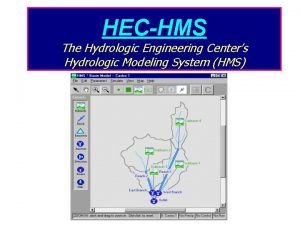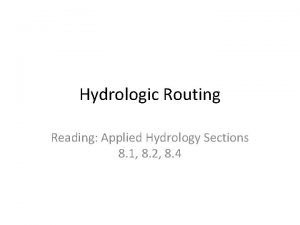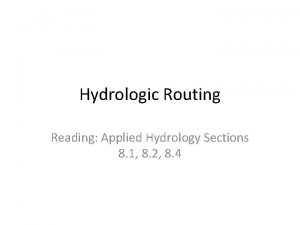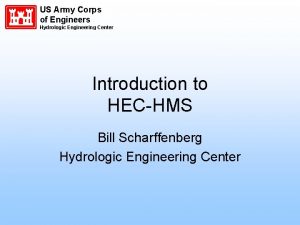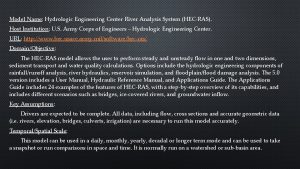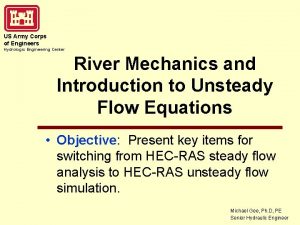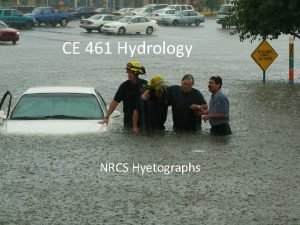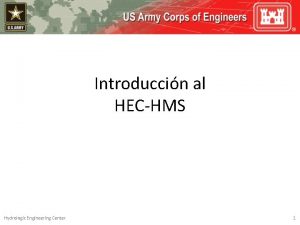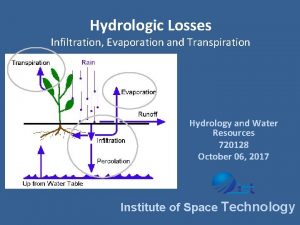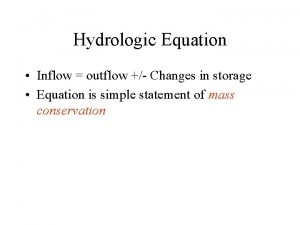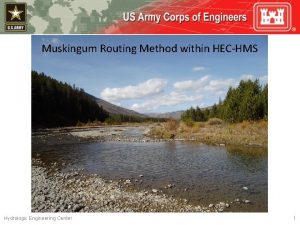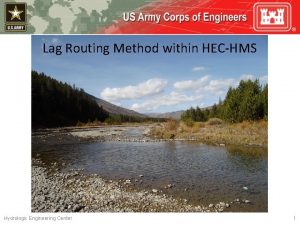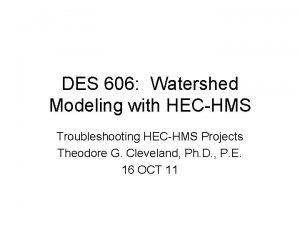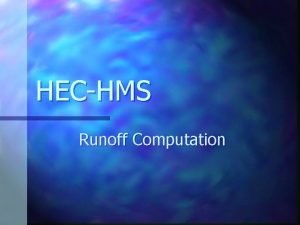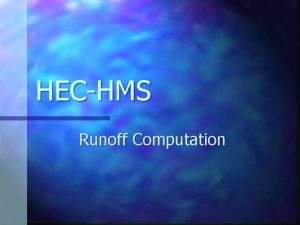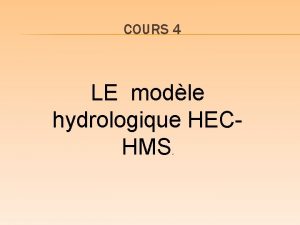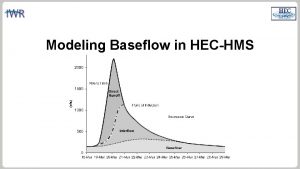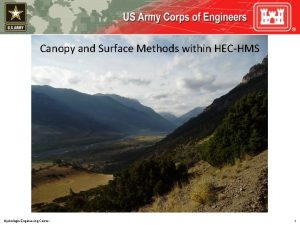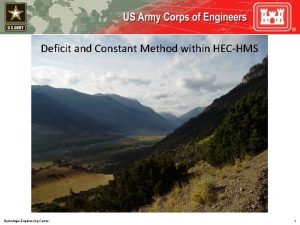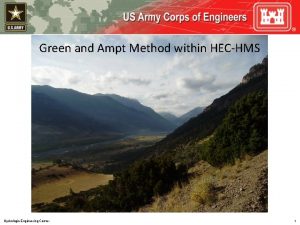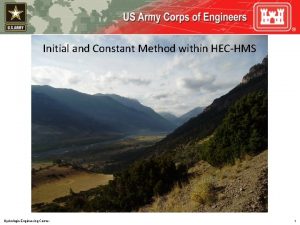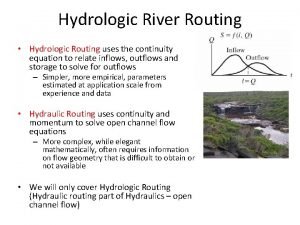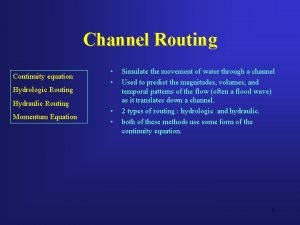Selecting an Appropriate Routing Technique within HECHMS Hydrologic


















- Slides: 18

Selecting an Appropriate Routing Technique within HEC-HMS Hydrologic Engineering Center 1

Objectives • Assist modelers in the identification of an appropriate hydrologic or hydraulic routing method for a given problem • Discuss important study objectives and physical considerations • Provide rules of thumb Hydrologic Engineering Center 2

Keep In Mind… • All routing models are simplifications of the real world • An appropriate method captures the significant aspects of the system in question • An appropriate method provides the necessary information to meet study objectives Hydrologic Engineering Center 3

Questions to Ask Yourself • For each routing method: – How does it represent open channel flow processes? – What are it’s advantages and disadvantages? – What input data is required? – Can it supply the required output information? Hydrologic Engineering Center 4

Additional Factors to Consider • What type of study / what will be considered? – Reservoir design – Channel modifications – System effects (changes to the watershed) • Level of detail – Feasibility, planning, or design • Characteristics of the physical system in question • Familiarity and experience of the modeler • Time and Costs Hydrologic Engineering Center 5

Backwater Effects • Caused by tides, confluences, hydraulic structures, bridges, culverts, channel constrictions, and other obstructions • Hydrologic methods generally do not simulate backwater effects – Modified Puls can • Hydraulic methods generally do account for backwater – Kinematic Wave cannot Hydrologic Engineering Center 6

Floodplains • Can have significant impact on routed hydrograph • Important factors include: – Width – Slope – Roughness • Separate overbanks from main channel Hydrologic Engineering Center 7

Floodplains • Methods that can simulate flood plain effects: – Muskingum-Cunge w/ an eight point cross section – Modified Puls • Very wide and flat floodplains may require 2 D modeling – 2 D Diffusion Wave method Hydrologic Engineering Center 8

Confluences and Flow Splits • If no significant backwater: – All hydrologic methods can apply • If significant backwater, use: – Diffusion Wave – Modified Puls • For full networks with flow splits and reversals, full dynamic wave equations should be applied – e. g. HEC-RAS Hydrologic Engineering Center 9

Supercritical Flow • Hydrologic methods do not know about flow regime • If supercritical for a long reach, or stage is important, supercritical reach should be isolated • Intermittent supercritical can be ignored for hydrologic routing purposes Hydrologic Engineering Center 10

Observed Data • If observed data is not available: – Physically based methods should be used • Easier to estimate input data • More reliable results • When observed data is available: – Must calibrate and validate – Use statistical metrics Hydrologic Engineering Center 11

Channel Slope • As slope gets flatter, hydrologic methods begin to fail – Simplifications become more and more important – e. g. acceleration terms w/in Momentum equation Hydrologic Engineering Center 12

Slope and Rate-of-Rise Rules of Thumb • When bed slope > 10 ft/mi: – Most hydrologic routing methods are okay to use • When bed slope < 2 ft/mi: – Most hydrologic routing methods will produce erroneous results • When bed slope is between 2 and 10 ft/mi: – Depends upon the channel properties, chosen method, and rate-of-rise of the hydrograph Hydrologic Engineering Center 13

Ponce (1978) Criterion • Kinematic Wave routed peak within 5% provided the following is satisfied: where: Hydrologic Engineering Center T = Hydrograph duration in seconds So = Friction or Bed Slope (ft/ft) Uo = Reference mean velocity (ft/sec) do = Reference flow depth (ft) 14

Ponce (1978) Criterion • Diffusion Wave routed peak within 5% provided the following is satisfied: where: Hydrologic Engineering Center T = Hydrograph duration in seconds So = Friction or Bed Slope (ft/ft) g = Gravitational acceleration (ft/sec 2) do = Reference flow depth (ft) 15

Factors to Consider Appropriate Methods NOT Appropriate No observed hydrograph data available for calibration -Diffusion Wave -Kinematic Wave -Muskingum-Cunge -Modified Puls* -Lag -Muskingum Significant backwater that will influence hydrograph -Diffusion Wave -Modified Puls* -Lag -Kinematic Wave -Muskingum-Cunge Flood will go out of bank into the floodplain -Diffusion Wave -Modified Puls* -Muskingum-Cunge -Muskingum -Lag -Kinematic Wave *with storage-discharge curves produced by a hydraulic model Hydrologic Engineering Center 16

Factors to Consider Appropriate Methods NOT Appropriate Slope > 10 ft/mi and: -Most, if not all, methods -None 2 < Slope < 10 ft/mi and: -Diffusion Wave -Muskingum-Cunge -Modified Puls* -Muskingum -Kinematic Wave -Lag Slope < 2 ft/mi and: -Diffusion Wave -Muskingum-Cunge -Modified Puls* -Kinematic Wave -Muskingum -Lag Slope < 2 ft/mi and: -Full Dynamic Wave -All other methods Hydrologic Engineering Center T = Hydrograph Duration [sec] S 0 = Friction Slope [ft/ft] u 0 = Average Velocity [ft/s] d 0 = Flow Depth [ft] *with storage-discharge curves produced by a hydraulic model 17

Conclusion • The most appropriate method depends upon many considerations • Important physical considerations include backwater effects, floodplains, and channel slope • Slope rule of thumb and Ponce criterion can be used to narrow the list of appropriate methods Hydrologic Engineering Center 18
 Hydrologic routing and hydraulic routing
Hydrologic routing and hydraulic routing Hechms
Hechms Hydrologic routing
Hydrologic routing Flood routing example
Flood routing example Hydrologic routing
Hydrologic routing Selecting text means selecting
Selecting text means selecting Clock and power routing in vlsi
Clock and power routing in vlsi Mark tinka
Mark tinka Water cycle the hydrologic cycle
Water cycle the hydrologic cycle Hydrologic engineering center
Hydrologic engineering center Hydrologic abstractions
Hydrologic abstractions River analysis system
River analysis system Hydrologic engineering center
Hydrologic engineering center Objectiveable
Objectiveable Hydrologic engineering center
Hydrologic engineering center Hydrologic losses
Hydrologic losses Hydrologic continuity equation
Hydrologic continuity equation Write the inflow as a formula
Write the inflow as a formula Specific purpose statements
Specific purpose statements

